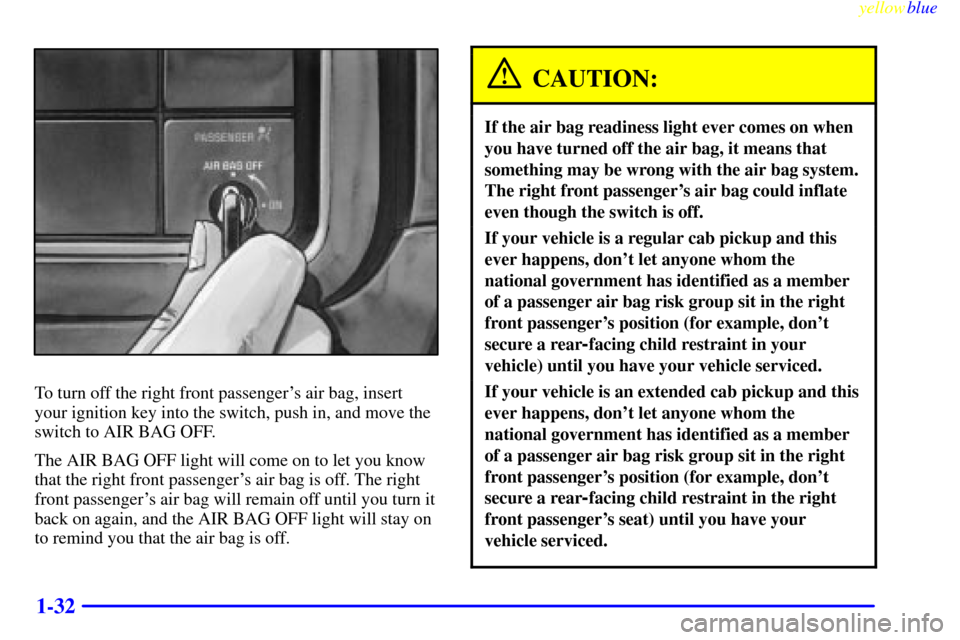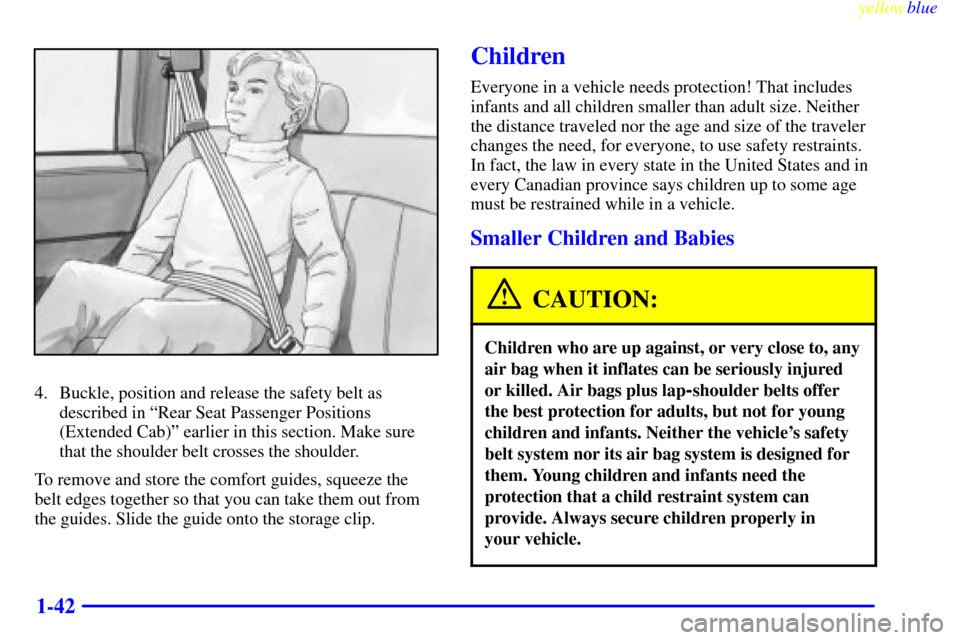Page 3 of 421
ii
Table of Contents
Keys and Door Locks
Keyless Entry System (If Equipped)
Tailgate
Automatic Transmission
Manual Transmission Operation
Four-Wheel Drive Operation (If Equipped)
Parking Brake
Windows
Tilt Wheel (If Equipped)
Turn Signal/Multifunction LeverWindshield Wipers
Cruise Control
Interior and Exterior Lamps
Mirrors
Storage Compartments
Accessory Power Outlets
OnStar® System (Option)
Instrument Panel, Warning Lights and Gages
Message Center
Oil Life Seats and Seat Controls
Safety BeltsAir Bag System
Child Restraints
Section
1
Section
2
Seats and Restraint Systems
Features and Controls
Page 13 of 421
1-
yellowblue
1-1
Section 1 Seats and Restraint Systems
Here you'll find information about the seats in your vehicle and how to use your safety belts properly. You can also
learn about some things you should not do with air bags and safety belts.
1
-2 Seats and Seat Controls
1
-11 Safety Belts: They're for Everyone
1
-15 Here Are Questions Many People Ask About
Safety Belts
-- and the Answers
1
-16 How to Wear Safety Belts Properly
1
-16 Driver Position
1
-23 Safety Belt Use During Pregnancy
1
-24 Right Front Passenger Position
1
-24 Air Bag System
1
-35 Center Passenger Position1
-36 Rear Seat Passengers
1
-40 Rear Safety Belt Comfort Guides for Children
and Small Adults
1
-42 Children
1
-46 Child Restraints
1
-62 Larger Children
1
-65 Safety Belt Extender
1
-65 Checking Your Restraint Systems
1
-65 Replacing Restraint System Parts After
a Crash
Page 43 of 421

yellowblue
1-31
This switch should only be turned to AIR BAG OFF if
the person in the right front passenger's position is a
member of a passenger risk group identified by the
national government as follows:
Infant. An infant (less than 1 year old) must ride in the
front seat because:
�my vehicle has no rear seat;
�my vehicle has a rear seat too small to accommodate
a rear
-facing infant seat; or
�the infant has a medical condition which, according
to the infant's physician, makes it necessary for the
infant to ride in the front seat so that the driver can
constantly monitor the child's condition.
Child age 1 to 12.
A child age 1 to 12 must ride in the
front seat because:
�my vehicle has no rear seat;
�although children ages 1 to 12 ride in the rear
seat(s) whenever possible, children ages 1 to 12
sometimes must ride in the front because no space is
available in the rear seat(s) of my vehicle; or
�the child has a medical condition which, according
to the child's physician, makes it necessary for the
child to ride in the front seat so that the driver can
constantly monitor the child's condition.Medical Condition.
A passenger has a medical
condition which, according to his or her physician:
�causes the passenger air bag to pose a special risk
for the passenger; and
�makes the potential harm from the passenger air bag
in a crash greater than the potential harm from
turning off the air bag and allowing the passenger,
even if belted, to hit the dashboard or windshield in
a crash.
CAUTION:
If the right front passenger's air bag is turned off
for a person who isn't in a risk group identified
by the national government, that person won't
have the extra protection of an air bag. In a
crash, the air bag wouldn't be able to inflate and
help protect the person sitting there. Don't turn
off the passenger's air bag unless the person
sitting there is in a risk group.
Page 44 of 421

yellowblue
1-32
To turn off the right front passenger's air bag, insert
your ignition key into the switch, push in, and move the
switch to AIR BAG OFF.
The AIR BAG OFF light will come on to let you know
that the right front passenger's air bag is off. The right
front passenger's air bag will remain off until you turn it
back on again, and the AIR BAG OFF light will stay on
to remind you that the air bag is off.
CAUTION:
If the air bag readiness light ever comes on when
you have turned off the air bag, it means that
something may be wrong with the air bag system.
The right front passenger's air bag could inflate
even though the switch is off.
If your vehicle is a regular cab pickup and this
ever happens, don't let anyone whom the
national government has identified as a member
of a passenger air bag risk group sit in the right
front passenger's position (for example, don't
secure a rear
-facing child restraint in your
vehicle) until you have your vehicle serviced.
If your vehicle is an extended cab pickup and this
ever happens, don't let anyone whom the
national government has identified as a member
of a passenger air bag risk group sit in the right
front passenger's position (for example, don't
secure a rear
-facing child restraint in the right
front passenger's seat) until you have your
vehicle serviced.
Page 52 of 421
yellowblue
1-40
Rear Safety Belt Comfort Guides for
Children and Small Adults
If your vehicle has a rear seat, your vehicle has shoulder
belt comfort guides. This feature will provide added
safety belt comfort for children who have outgrown
child restraints and for small adults. When installed on a
shoulder belt, the comfort guide pulls the belt away
from the neck and head.
There is one guide for each outside passenger position in
the rear seat. To provide added safety belt comfort for
children who have outgrown child restraints and for
smaller adults, the comfort guides may be installed on
the shoulder belts. Here's how to install a comfort guide
and use the safety belt:
1. Remove the guide from its storage clip on the
interior body.
Page 54 of 421

yellowblue
1-42
4. Buckle, position and release the safety belt as
described in ªRear Seat Passenger Positions
(Extended Cab)º earlier in this section. Make sure
that the shoulder belt crosses the shoulder.
To remove and store the comfort guides, squeeze the
belt edges together so that you can take them out from
the guides. Slide the guide onto the storage clip.
Children
Everyone in a vehicle needs protection! That includes
infants and all children smaller than adult size. Neither
the distance traveled nor the age and size of the traveler
changes the need, for everyone, to use safety restraints.
In fact, the law in every state in the United States and in
every Canadian province says children up to some age
must be restrained while in a vehicle.
Smaller Children and Babies
CAUTION:
Children who are up against, or very close to, any
air bag when it inflates can be seriously injured
or killed. Air bags plus lap
-shoulder belts offer
the best protection for adults, but not for young
children and infants. Neither the vehicle's safety
belt system nor its air bag system is designed for
them. Young children and infants need the
protection that a child restraint system can
provide. Always secure children properly in
your vehicle.
Page 57 of 421
yellowblue
1-45
CAUTION: (Continued)
Secure the baby in an infant restraint. If you're
using the infant restraint in the right front
passenger's position, be sure to turn off the air
bag. See ªAir Bag Off Switchº and ªSecuring a
Child Restraint in the Right Front Seat Positionº
in the Index for more on this, including
important safety information.
Page 60 of 421
yellowblue
1-48
A forward-facing child restraint (C-E) positions
a child upright to face forward in the vehicle.
These forward
-facing restraints are designed to
help protect children who are from 20 to 40 lbs.
(9 to 18 kg) and about 26 to 40 inches
(66 to 102 cm) in height, or up to around four years
of age. One type, a convertible restraint, is
designed to be used either as a rear
-facing infant
seat or a forward
-facing child seat.